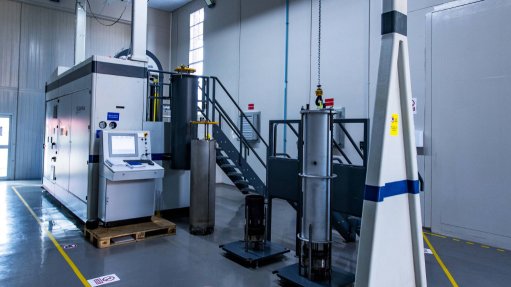Supplier highlights safety component of gas detectors


SAMANTHA PELATI Trigas distributes calibration gas in smaller quantities, and this is used by instrumentation specialists to calibrate and bump test the gas detector units
Portable gas detectors are crucial for safety in various industries, as they provide real-time monitoring of hazardous gases. This, in turn, allows for the timely detection of leaks, the prevention of accidents and ensures regulatory compliance, highlights gas detection supplier Trigas sales and marketing administrator Samantha Pelati.
The portable gas detectors offered by Trigas in industries such as petrochemical sites, chemical processing and manufacturing can monitor toxic gases, flammable gases and oxygen- deficient environments (confined spaces).
Pelati adds that when handling any form of calibration gas, there needs to be a certificate of analysis that proves the exact composition of a gas cylinder and demonstrates an understanding of the gas compliance certifications.
Trigas is ISO 9001:2015 accredited for maintaining a quality management system and demonstrating efficiency throughout its operations.
The company primarily specialises in gas and flame detection, as well as connected safety solutions. It offers numerous products and services, including fixed and portable gas detection equipment, laser-based gas detection systems and solutions for connected site monitoring and personal safety monitoring.
Its monitoring systems focus on assessing combustible gases and toxic gases, including, but not limited to, methane, ammonia, carbon monoxide, CO2, and hydrogen sulphide, as well as oxygen levels, particularly those in petrochemicals plants, opencast mines and manufacturing facilities.
Highlighting the application of the company’s gas detection systems, Pelati notes that portable gas detectors, such as those offered by Trigas, are used to detect the presence and concentration of flammable and hazardous gases in the immediate environment of workers.
These portable devices are typically worn by individuals, or area monitors are placed in specific locations, to monitor potentially harmful gases and provide real-time alerts when gas levels exceed the appropriate safety limits.
“There are various industries within South Africa and Africa that use gas in their processes, or the gases are a byproduct of their processes. For example, laser gas detection is crucial in the petrochemicals industry for detecting and monitoring various gases, including methane, hydrogen sulphide and specifically CO2 to ensure safety, provide environmental monitoring and help optimise processes,” Pelati explains.
Trend Adaptation, Quality Standards
Amid the gas industry’s undergoing significant changes driven by factors such as the increased demand for specific gases, digitalisation, automation, AI and the Internet of Things, Pelati highlights that adapting to these trends is crucial for Trigas to remain competitive.
The company is actively adapting by partnering with leading innovators in gas detection technology, focusing on distributing products featuring flexible and wearable designs; it is also paying close attention to the complexity of data management, owing to the need to develop lasting solutions for efficient data collection, analysis and interpretation to allow for informed decision-making.
Pelati also highlights the importance of leveraging predictive analytics to anticipate leaks, using Web-based platforms for enhanced detection, and creating smart, real-time monitoring solutions through wireless connectivity and cloud platforms.
Additionally, Trigas employs several quality- control measures to ensure the purity and consistency of its products, which include rigorous testing procedures and a strict adherence to industry standards.
“We do distribute calibration gas in smaller quantities, and this is usually used by instrumentation specialists to calibrate and bump test the gas detector units, which is crucial to minimising the risk of inaccuracies and safety hazards on site.”
Smaller cylinders reduce waste and cost when used in low-use applications. They have lower internal volume and pressure compared to larger cylinders, which reduces risk during transportation and use. Faster depletion of these smaller cylinders compared to larger ones ensures more frequent replacement, leading to fresher gas, thereby ensuring a more consistent and reliable calibration process, she concludes.
Article Enquiry
Email Article
Save Article
Feedback
To advertise email advertising@creamermedia.co.za or click here
Comments
Press Office
Announcements
What's On
Subscribe to improve your user experience...
Option 1 (equivalent of R125 a month):
Receive a weekly copy of Creamer Media's Engineering News & Mining Weekly magazine
(print copy for those in South Africa and e-magazine for those outside of South Africa)
Receive daily email newsletters
Access to full search results
Access archive of magazine back copies
Access to Projects in Progress
Access to ONE Research Report of your choice in PDF format
Option 2 (equivalent of R375 a month):
All benefits from Option 1
PLUS
Access to Creamer Media's Research Channel Africa for ALL Research Reports, in PDF format, on various industrial and mining sectors
including Electricity; Water; Energy Transition; Hydrogen; Roads, Rail and Ports; Coal; Gold; Platinum; Battery Metals; etc.
Already a subscriber?
Forgotten your password?
Receive weekly copy of Creamer Media's Engineering News & Mining Weekly magazine (print copy for those in South Africa and e-magazine for those outside of South Africa)
➕
Recieve daily email newsletters
➕
Access to full search results
➕
Access archive of magazine back copies
➕
Access to Projects in Progress
➕
Access to ONE Research Report of your choice in PDF format
RESEARCH CHANNEL AFRICA
R4500 (equivalent of R375 a month)
SUBSCRIBEAll benefits from Option 1
➕
Access to Creamer Media's Research Channel Africa for ALL Research Reports on various industrial and mining sectors, in PDF format, including on:
Electricity
➕
Water
➕
Energy Transition
➕
Hydrogen
➕
Roads, Rail and Ports
➕
Coal
➕
Gold
➕
Platinum
➕
Battery Metals
➕
etc.
Receive all benefits from Option 1 or Option 2 delivered to numerous people at your company
➕
Multiple User names and Passwords for simultaneous log-ins
➕
Intranet integration access to all in your organisation

















